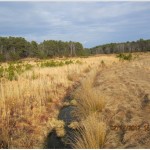
Nature almost always finds it way back. What man has rent asunder, nature can re-stitch, given time. And nature has the time.
So it is with the evolution of the Cape’s swamps to cranberry bogs and back to swamps, an evolution and de-evolution, if you will. Many of the Cape’s cranberry bogs were white cedar swamps in a previous life. To see the full progression of Mother’s Bog since 2006, click here.
In 2006 & 2007, the Town of Brewster purchased an assemblage of properties totaling 59 acres straddling Slough Road in SW Brewster for conservation. Included was an 8-acre working cranberry bog called Mother’s Bog, named after “Mother” Louise Crowell, whose family ran the bogs for many years. The Dennis town line ran through the bogs and the Dennis Water District contributed $1 million towards Brewster’s purchase– -a nice gesture of intermunicipal cooperation. The Brewster Conservation Trust bought an adjoining 4-acre parcel on Pine Pond, adding to the conservation area.

Part of the Dennis Water District’s interest was to see the bogs returned to native habitat, fearing the continued use of cranberry-growing herbicides and the like so close to its main wellfield. This same bog had destroyed thousands of herring fry in the 1990s, sucking them up from Walker’s Pond through an irrigation pump. So Brewster conservation officials were not opposed to the bog’s abandonment. And the sellers had no issue with that idea either.
How quickly the bogs responded, springing back to life from their devoted service to cranberries! Wetland plants, such as soft rush, almost immediately took hold. With its tawny tassels, soft rush is just as pleasant to look over as a bog tightly wrapped in a burgundy tarp of cranberry vines.
The Brewster Department of Natural Resources manages Mother’s Bog on behalf of the Town Conservation Commission. DNR Director Chris Miller is concerned that the emerging pitch pines not take over the bog, keeping it a more open wetland. “We might want a work party in there to remove the pines soon, before they get too tall to manage. Some highbush blueberry bushes might be planted to introduce some more diversity to the bogs.” Thus, a man-made assist back to nature.
Brewster still has its share of cranberry bogs still in production. The most visible is little Bill’s Bog, right on Route 124. Most of the bogs are clustered around ponds, such as Elbow, Griffiths, Seymours and Pine Ponds, owing to their utility as an irrigation source. Brewster native Washington “Wash” Chase ran the large cranberry bog on Route 6A in East Brewster right up until his death in 2008 at the age of 95, but it has “de-evolved” since then. For a map showing the location of Brewster’s Bogs, click here.
Brewster’s bogs, both those still in production for cranberries and those being restored to more natural wetlands, are a beautiful and important natural resource.

